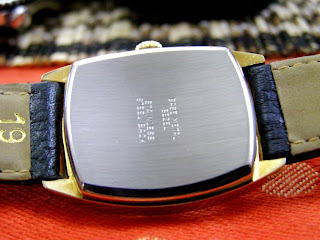






FRANCE MADE NEW OLD STOCK PAUL GARNIER CURVEX MEN'S WRISTWATCH CIRCA 1960's
SHINNING SILVER TONE DIAL WITH DATE WINDOW AT 3 O'CLOCK
CRYSTAL IS CLEAN, NO CRACK NO SCRATCHES
THE SWISS ETA SA DUROWE BASED 17 JEWELS MANUAL WINDING MOVEMENT CAL. 139-2
GOLD TONE LUMINOUS METAL HANDS
RAISED GOLD/BLACK BATON LUMINOUS MARKERS
GOLD PLATED CURVEX SQUARE CASE MEASURES APPROXIMATELY 29mm INCLUDING THE CROWN AND 38mm LUG TO LUG
UNSIGNED GP CROWN
NEW GENUINE BLACK BAND FITS 8.5" WRIST
DISCONTINUED MODEL... !
WORKING CONDITION, KEEPING TIME AND RECENTLY SERVICED
PRICE: RM700.00 (NEGOTIABLE)
Paul Garnier (1801-1869) was an a 19th century inventor, clock and watch maker who began in Paris in 1825. Paul Garnier was founded in 1825 in Hbr du Roi, Paris, France and specialized in clocks in railway stations. The Garnier company made watches with Swiss movement and casing were made in France and German. They were taken over in 1933 by Leon Hatot (the ones who developed the "Rolls" early automatic watch, later made by Blancpain) who were known for their electronic ATO clocks. These were marketed also under the name "ATO - Paul Garnier".
In 1967, the electrical horology branch of Lepaute took over the ATO production. A new type of seven segment digital clock was developed in 1978 and was immediately taken up by the French railways "SNCF". These clocks achieved such rapid success that they were copied on a grand scale. Although the Hatot Company adopted new production techniques and used miniature quartz crystals as time standards, the costs of research and development could not be recovered in small to medium series production. Competition from South East Asia forced the Hatot Company to abandon its industrial branch and concentrate on the sale of quality watches and domestic battery electric clocks marketed under the names "ATO-LEPAUTE" and "ATO - PAUL GARNIER".
History of Durowe - Watch Movement Manufacturer
DUROWE (Deutsche Uhrenrohwerke) is a German watch movement manufacturer that in the 1970s was the largest producer of watch movements in Germany.
Erich Lacher intended DUROWE to supply not only LACO but other German watchmakers as well. DUROWE grew strongly in the 1930s, with the number of movements produced peaking at 30,000 per month until the outbreak of the Second World War. During the war, DUROWE continued to manufacture movements, in particular the large chronometer-grade movements used in the Beobachtungsuhren (B-Uhr) commissioned by the German government for use by the Luftwaffe, of which Laco was one of five manufacturers.
At the end of the war, the DUROWE factory in Pforzheim was destroyed by an Allied bombing raid. However, DUROWE and Laco had recommenced production by 1949. With the assistance of the Marshall Plan, a five-storey building to house the Laco and DUROWE operations was built which housed more than 1,400 workers by the middle of the 1950s. Production of movements rose to 80,000 per month.
During the 1950s, DUROWE developed a number of innovative movements, including one of the first German automatic movements and some of the slimmest German movements manufactured at the time. However, due to a downturn in business, the DUROWE and Laco brands were sold to the Timex Corporation on 1 February 1959. The primary motivation for the purchase was so that Timex could gain access to research that DUROWE had done into electronic timepieces, however the watches were generally not commercially successful. Six and a half years later, on 1 September 1965, DUROWE was purchased by the Swiss movement manufacturer ETA SA to gain access to the European markets of the then European Economic Community. ETA accordingly re-focused DUROWE on the production of mechanical watch movements.



No comments:
Post a Comment